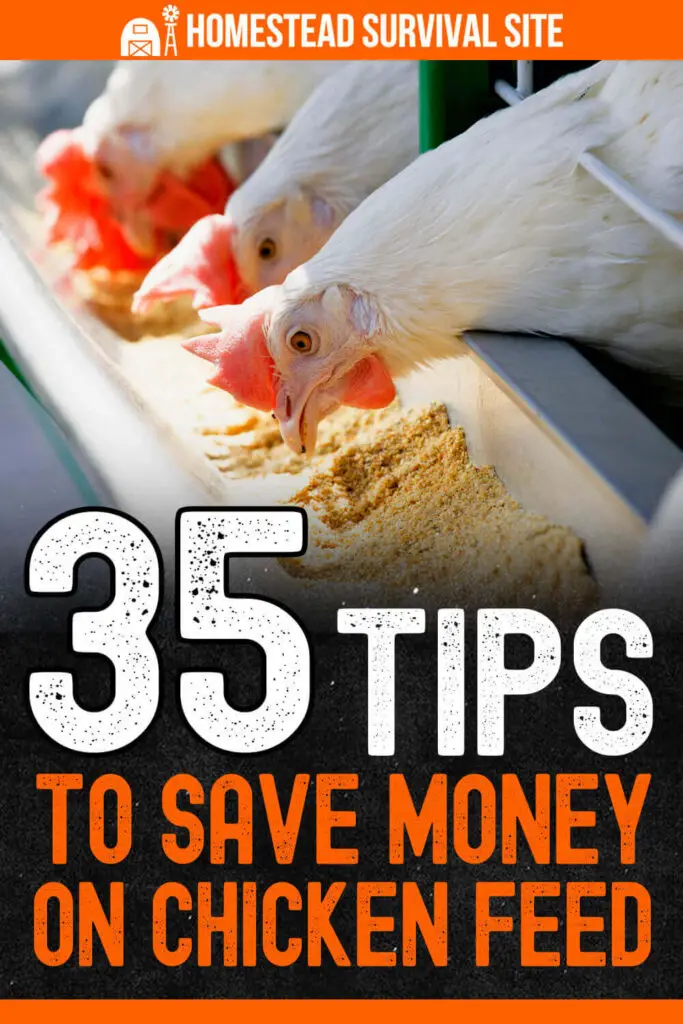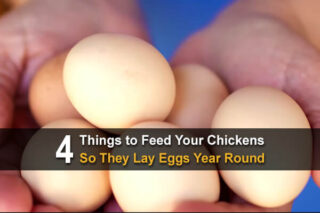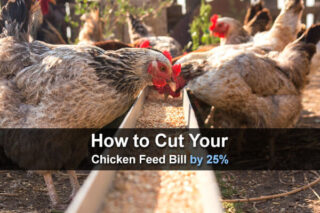Estimated reading time: 13 minutes
When the cost of eggs skyrocketed, more families than ever turned to raising their own chickens for eggs. But if you’re spending more money on feed for your chickens than you are on purchasing eggs at the store, there’s less of a benefit to raising them.
For example, I could easily spend $30 for a 40-pound bag of organic chicken food. On the other hand, a dozen eggs near me cost about $5 – so I could buy six dozen eggs for a single bag of chicken food. From a financial standpoint, having my own chickens makes is less appealing (although there are other good reasons to raise chickens, such as fun, food security, and nutrition).
But after years of raising and breeding chickens, I’ve come up with some great tips to save money on chicken feed. Let’s talk about it!
Want to save this post for later? Click Here to Pin It On Pinterest!
1. Shop The Sales
This may be a no-brainer, but the simplest way to save money on chicken feed is to wait until there is a good sale and stock up. You can easily save 10 to 20% on the cost of feed if you find a good sale!
2. Shop around
There are plenty of places to purchase chicken feed where I live, from smaller farm stores to larger big box stores. Call around to find the best price per pound. You might be surprised who has it the cheapest!
3. Pick it up yourself
I can have my chicken food delivered and stacked for me for a small fee. I do this when I’m busy and need to stock up on large amounts. But when I need to save dollars, I just go and pick it up myself to save on delivery costs.
4. Use reward points
The last time I purchased chicken feed at Tractor Supply, I had a $10 off birthday coupon, which covered a large portion of a bag of feed. They offer other discounts throughout the year, which helps me save cash on feed bags.
5. Buy scratch grains
Our local feed mill sells 50-pound bags of scratch grains, which are significantly less expensive than standard chicken feed. Scratch grains are a mix of leftover whole grains, whole, and cracked corn. They aren’t a substitute for layer feed but make for an excellent and inexpensive supplement. Scratch grains are easily half the cost – or less – of a standard bag of chicken feed.
6. Hay
Chickens don’t eat hay like goats do, but you can supplement their feed with it if you have some extra hay. Whenever I feed my goat, the chickens love to get in on the action. They’ll dig through the flakes of hay for any seeds, bits of grain, and bugs that are hiding inside.
7. Weeds
One summer day, when my lawn was a little overdue for a mowing, I watched with delight as my rooster gobbled up a fluffy white dandelion head. Any time you weed your garden or flowerbeds, gather up the weeds and feed them to your chickens. They love weeds such as plantain, dandelion, purslane, and chickweed. As long as they are well-fed, they’ll most likely avoid poisonous plants like nightshades.
8. Compost
One of my favorite ways to feed chickens is to give them access to the compost bin. If your chicken pen is large enough, you can even keep your compost bin inside of it. Your compost should be a mixture of browns and greens – for example, grass clippings and dead leaves, vegetable scraps, weeds, and twigs. The compost pile will attract plenty of worms, maggots,and beetles that your chickens will love.
They’ll dig through the pile, picking out bits of food, bugs, and any other tasty morsels that they can find. In return, they’ll leave behind their droppings and turn the pile for you, saving you hours of work. In return, you save time, money, and work and get wonderful compost.
9. Kitchen scraps
Food waste is a huge problem in America. So much food waste ends up in landfills, where it can’t decompose quickly enough because it is compressed to the point where air can’t get to it. My kids waste a lot of food, though, so the best way that I can stop food waste is to feed all of my kitchen scraps to my chickens.
I keep a plastic bucket with a lid in my kitchen. After each meal, I just scrape any scraps into the bucket. When the kids go outside to play, they love to take that bucket and dump it into the chicken pen. The chickens love it and get to eat the same nutritious, well-balanced food that I serve my family. Even better, it’s hilarious to watch them squabble and fight over a piece of lettuce or a nibble of hot dog.
Your chickens can eat almost anything that you can, but avoid giving them moldy or rotten food, avocadoes, green potatoes or skins, dried beans, chocolate, or candy. However, it is ok to give them leftover chicken! While you’re at it, ask your friends to save their scraps, too.
My friends routinely drop off their stale bread or flopped recipes. The chickens love it, and my friends feel good about saving waste (and getting spare eggs in return).
10. Clean out your fridge
Every 2 to 3 weeks, I need to clean out uneaten leftovers, wilting lettuce, and other items from the back of the fridge. Anything that isn’t moldy or rotten is fair game for the chickens. Stale bread, cereal that no one likes, and any crushed-up crackers or cookies can feed your fowl.
11. Freezer-burned food
Freezer-burned food is not always appetizing and palatable to humans, but if it is still safe to eat, you can cook it up and feed it to your chickens. Anything from old hamburgers to freezer-burned veggies can be cooked, baked, or fried up and used for chicken feed.
12. Feed back their eggs
If you have an abundance of eggs or you have eggs that are starting to get old, you can scramble them up and feed them to the chickens. The protein is good for them!
13. Feed them their shells
Wash and dry the shells and bake them in the oven at a low temperature until they are good and dried out. You can then pulverize the shells and give them to the chickens for extra calcium and grit, which will help them digest their food and give them stronger egg shells.
14. Debug your garden
Tomato hornworms, tobacco hornworms, and other types of bugs that grow in your garden can help you feed your chickens. Early in the morning, you can walk through your garden and pick off those large caterpillars that are clinging to your plants (you may want to use gloves for this!). Drop them in a pail of water and give it to your chickens. You’ll be saving your vegetables and feeding your chickens for free!
15. Garden prep
In the fall and spring, I let my chickens into my garden. In the spring, they’ll dig up lots of grubs and bugs that will eat my plants. They’ll turn over the soil, loosen it, and eat anything left over from the previous year.
After I’m done growing in the fall, I’ll let them in again to eat up any leftover produce, wilting plants, and bugs. They leave behind lots of droppings which will decompose over the winter and help get the garden ready for growing again.
16. Extra garden produce
The first year I planted a garden, I overplanted squash and ended up with a wagonload of squash and zucchini every day! It turned out to be great food for my chickens, alongside any tomatoes that had bugs, strawberries that were partially eaten, and other produce rejects that just weren’t appetizing.
17. Grow a chicken garden
Chickens love fresh greens, and you can grow them cheaply and easily to feed them. You may want to grow squash, sunflowers, lettuce, spinach, kale, mint, and basil directly in your chicken pen or in an area that your chickens can access. You could also grow peas, cabbage, cucumbers, dill, parsley, corn, wheat, or oats, just to name a few.
Growing herbs such as pineapple sage, lemon balm, and bee balm aren’t just good for the chickens. They also attract pollinators to your garden and more bugs for your chickens to eat. If you choose perennials such as mint, you’ll only have to plant it once, and it will come back year after year.
18. Grow berries
The woods surrounding my house are full of wild raspberries, which my chickens love. It’s a free, effortless food source, too. The berry bushes come back every year, and the chickens find them all on their own – it’s a healthy, nutritious food source that costs nothing.
19. Grow fruit trees
Fruit trees can be messy, especially mulberries, pear trees, or any other type of tree that drops its ripened fruit on the ground. However, if you grow these trees over your chicken pen, they’ll clean up the leftovers for you and get fed in the process.
20. Get pumpkins
There is a pumpkin patch just a few miles down the road from my homestead. At the end of the season, the farmer will sell truckloads of leftover pumpkins for a very small price – or even give them away before tilling any rotting pumpkins back into the soil.
Find a local pumpkin patch or pumpkin farmer and ask what they do with their leftovers. Chickens love pumpkins! Many pumpkin varieties will store for months in a cool, dry place, so you’ll be able to feed them to your chickens long after the growing season is over.
(As a bonus, my kids love smashing extra pumpkins open so the chickens can get to the seeds inside). Pumpkin seeds can help deworm your chickens, too.
21. Farmer’s markets
You may find that produce prices at farmer’s markets are drastically reduced at the end of the weekend, and some farmers will even give their extras away so they don’t have to cart them back to the farm.
Build good relationships with your local farmers at the market, and you may be able to strike up a great deal for their leftovers, so you can feed fresh produce to your chickens at a very cheap price.
22. Local restaurants
There are usually strict rules about what restaurants can do with their unused foods. However, depending on the laws where you live, if there is an independently-ownedrestaurant that has leftovers at the end of the day, they may be willing to pass them on to you for your chickens.
23. Grocery store rejects
Bakeries and grocery stores will sell day-old bread, older produce, or food past its expiration date at steep discounts. You can purchase this food on sale and feed it directly to your chickens.
24. Co-ops
Your local farmstore may have a co-op that you can join. You’ll be able to harness the buying power of a larger group of people, which saves you money in the long run. You’ll only have to pay for what you need, but you’ll be able to get bulk pricing to share with others in the co-op.
25. Join up with a few friends
If you don’t have a co-op, you may have a few friends that raise chickens, too. Join together and order in bulk. You may be able to get free delivery to someone’s house, where you can pick it up at your convenience.
26. Purchase directly from a farmer
Your local farmers may be willing to sell you extra grain or corn that they don’t need. Build good relationships with your local farmers, and they may be able to help you feed your chickens at a discount.
27. Raise your own mealworms
Chickens love mealworms, but they are very expensive if you purchase them, especially if you purchase freeze-dried mealworms. However, mealworms are very easy to raise.
A small Tupperware bin or fish tank can serve as a home for your mealworm colony. A few scoops of oatmeal is all it takes to feed them. Then, as the mealworms grow, you can sift them out and feed them to your chickens for next to nothing.
28. Raise your own earthworms
I used to raise earthworms for worm castings. That is until the bin got knocked over, and my chickens discovered all of the tasty treats hiding inside!
You can easily keep a small worm bin in a closet of your home, where you can feed them some leftover chicken scraps. A well-maintained bin doesn’t smell, and the worms will give you an amazing fertilizer for your plants and food for your chickens.
29. Make your own suet
Suet blocks are pricey, but you can make your own very inexpensively. Save that leftover grease the next time you cook hamburgers, ground beef, or even bacon.
While the grease is still warm, you can mix in veggies, nuts, or berries. Pour it into a paper cup and keep it in your freezer. Then, when you’re ready to feed it to your chickens, just tear off the paper cup and let your chickens enjoy the delicious protein treat.
30. Free-range
Free-ranging your chickens is a great option to cut down on the cost of feed. They’ll wander your yard, eating bugs, weeds and devouring ticks. They’ll also eat frogs, snakes, and small rodents, given the opportunity!
If you’re worried about predators, you can opt to free-range your chickens for a few hours in the afternoon or evening. Just let them out when you’re going to be around, and they’ll go back to their coop in the evening at dusk. Free-ranging for just a few hours a day will still help feed your chickens for less money.
31. Use a good chicken feeder
Chickens are notorious for wasting their food! But pellets are expensive, so use a good chicken feeder to keep the food from being wasted. Food that is spread out on the ground can turn to mush when wet and attract rodents. Save your money and your sanity by using a feeder that prevents waste.
32. Protect your feed from rodents and other animals
My son was shocked one day when he went to feed the chickens and realized the food was suddenly all gone! He had forgotten to put the lid on the can and close up the shed. Overnight, rats ate the food, and early in the morning, a few deer snuck into the shed and gobbled down the chicken feed, leaving nothing behind.
So $40 worth of chicken food became a single meal for a herd of deer! Since then, we’ve been putting our chicken feed in metal trash cans with tight-fitting lids to keep the rodents and the deer from eating it.
33. Don’t free-feed
Measure your grains. It can be tempting to fill up the chicken feeder for the week and not have to worry about it again until the following week. But bored chickens will play with their food and some will overeat.
A laying hen needs about ¼ pound of food per day. So measure out ¼ pound of food per chicken and feed that once a day. You’ll save money on wasted food and keep your chickens from over-indulging in a delicious snack.
34. Ferment grains
Fermenting grains will stretch your chicken food budget even further. Put a few cups of grains into a clean bucket and cover it with water. In about three days, the water will bubble, and the grains will ferment. They’ll grow probiotics that are good for your chickens and absorb water, which will help your chickens feel full, too. As a result, they’ll eat less, and you’ll save cash.
35. Have a plan for retired layers
On my homestead, the chickens get to stay around even after they quit laying eggs. But if you’re raising chickens just for eggs, you might not want to keep around chickens that are too old to produce. You’ll want to plan ahead so you know what you’ll do with those chickens. Some people keep them, like I do, while others will butcher or give away chickens that have stopped laying.
If you like feeding your chickens organic foods or even a vegetarian chicken feed, that’s just fine, but it is very expensive. And you won’t be able to prevent your chickens from eating any random bugs, weeds, or food that they discover in their environment anyway. So instead, you may want to consider using some of these easy tips to save money on your chicken’s feed.
Like this post? Don't Forget to Pin It On Pinterest!
You May Also Like:










